
1 Introduction and Dos & Don'ts
2 Setting Sail
3 Defensive Sailing
4 Coming in to Moorings
5 Knots
6 Reefing
7 Lowering the Mast
8 Handling a Yacht under Engine
9 Dinghies - Towing and Rigging
Author's Note

We all know how to sail - don't we? None of us ever make mistakes (well, hardly ever?).
- - - Sailing Hints - - -
This friendly little guide is not intended as an exhaustive instruction manual to teach you everything you ever need to know about sailing; instead it gives a few reminders and points to remember when sailing traditional Broads yachts, particularly with young and inexperienced crew (or even skippers).
- - - Think Ahead - - -
The most important thing to remember when handling heavy, often unresponsive, boats with a lot of very cold water around is to be careful and anticipate what might happen. This does not mean that sailing has to be boring - often far from it! What it does mean is trying your hardest to avoid hitting any other boats or the bank (irrespective of 'rights'). Also make every possible effort to avoid losing too many crew overboard; some would say you shouldn't lose any crew, but they haven't seen some of the noisy crew members I've had to put up with.
- - - Look Out - No Brakes! - - -
The heaviness of the yachts (especially the wooden ones) makes them reluctant to stop - always allow plenty of time to slow down when approaching a mooring, by spilling wind out of the sails or heading to Windward. This principle particularly applies when under engine, because the weak little motors provided have very little stopping power (even from the sluggish maximum forward speed); use several bursts of 'Astern' to kill virtually all the boat's way before you get close to the bank.
- - - That Water's Wet! - - -
Lifejackets or Buoyancy Aids should always be worn (and zipped up/tied) when outside the cabin if the boat is under way, and when working on the rigging or off-side deck of a moored yacht. Never use an arm or a leg to fend off the boat if you are about to bump into the bank or another boat. Don't even think of 'boom-walking' or letting even the lightest crew-member sit on the end of the boom - the mast is very likely to break, or they will fall in and get very wet and cold. Be particularly wary of crew at the Lee Shrouds when reaching in a strong wind; if the mast breaks it could be very messy, or if you heel a bit further and wash the decks they may get washed overboard (see 'wet & cold', above).
- - - Go For It! - - -
Enough of spreading doom and gloom - what you should be doing is setting your sails and steering a course to get the very best out of your yacht. Remember also that you should have the right amount of sail set for the conditions, in a strong wind you can often sail faster with a reef or two in.
- - - "The Boat did it by Itself" - - -
There is always more to learn about sailing, but one thing you will find is that the more proficient you get, the more you are in control, rather than the boat apparently doing things unexpectedly. With the big, heavy yachts on the Broads, combined with the confined sailing area and fluky winds, it can often seem that your boat has a mind of its own. Try to learn to read the wind and the water to anticipate this, and be in control yourself, rather than a victim of circumstances.
- - - Watch Your Language - - -
Also, try to use the 'proper' sailing terms whenever possible. They really do save confusion, but while you are getting your crew used to this new language try to explain or give an 'ordinary' word as well. In this booklet such terms are normally given a Capital Letter, to help you remember.
- - - Sailing Solo or in a Group? - - -
A lot of the ways of doing things described in this little guide (especially getting out of minor difficulties) assume that there are other boats nearby who can be called upon to assist. Even if you are not sailing in a group of yachts, which happens to be this author's main experience, you will find a remarkable camaraderie between boaters, so do not be afraid to ask a complete stanger.
- - - What's That in Old Money? - - -
Measurements are (mostly) given in good old-fashioned Imperial units, because these are probably more familiar to most people. Anyway, trying to metricate the traditional yachts somehow doesn't seem appropriate.
Cap'n Jeremy's Helpful Hints - Back to Contents
So, you've got a yacht, a willing but not fully-trained crew, and you want to go sailing.
We'll assume at this point that you've got rid of the Awning and all the other bits & pieces which don't have anything to do with sailing the boat, and that all the Halyards are attached to the appropriate bits of sail.
Also, we will look at the procedure for a Gaff-rigged yacht - a Bermuda rig (such as on a Javelin) is easier. Yet another assumption is that you put up the Mainsail before the Jib (the order is not usually critical - if you hoist the Main first the boat may try to sail away, or with the Jib hoisted the Clew flaps around and the Jib Sheet shackle attacks your legs while you're hauling up the Mainsail).
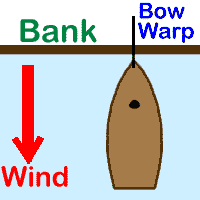 For this, you need to be on the Windward shore (where the wind is coming from), with only the Bow Warp holding the yacht. This may mean Quanting or motoring to the other bank, or another nearby section of river. If the wind is blowing parallel with the bank and you are the wrong way round, you may need to turn your yacht by holding onto the Bow Warp and pushing the Stern out (a strong current might complicate this operation!).
For this, you need to be on the Windward shore (where the wind is coming from), with only the Bow Warp holding the yacht. This may mean Quanting or motoring to the other bank, or another nearby section of river. If the wind is blowing parallel with the bank and you are the wrong way round, you may need to turn your yacht by holding onto the Bow Warp and pushing the Stern out (a strong current might complicate this operation!).
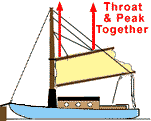 Keep the Gaff roughly at the angle it will end up when fully hoisted (but definitely with the Peak higher than the Throat)
as you raise it - this makes it less likely to jam on the mast or rip the sail. Once the Luff (leading edge) of the sail
is nearly tight, stop hauling on the Peak and 'Sweat' the Throat Halyard (tuck it under a cleat, pull out on the main
length then up on the free end) until it is really tight - this means you won't spill wind out of the Luff of the sail.
Keep the Gaff roughly at the angle it will end up when fully hoisted (but definitely with the Peak higher than the Throat)
as you raise it - this makes it less likely to jam on the mast or rip the sail. Once the Luff (leading edge) of the sail
is nearly tight, stop hauling on the Peak and 'Sweat' the Throat Halyard (tuck it under a cleat, pull out on the main
length then up on the free end) until it is really tight - this means you won't spill wind out of the Luff of the sail.
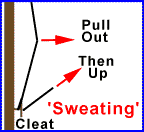 Haul on the Jib Halyard, once tight 'sweat' it (as (4) above) to get the sail really taut. A loose Jib will mean you can't sail as close to the wind and the sail also supports the strain on the Mast (supplementing the Forestay).
Haul on the Jib Halyard, once tight 'sweat' it (as (4) above) to get the sail really taut. A loose Jib will mean you can't sail as close to the wind and the sail also supports the strain on the Mast (supplementing the Forestay).
You are now ready to set sail. Unfortunately, the Bows are pointing straight at the bank and the yacht is probably trying to go that way as well.
You might think that you could push off or drift back from the bank with the wind, then fill the sails and be away; sometimes it is that easy, but not always. As soon as the mainsail starts to fill, it acts like an enormous weather-vane on the Stern to try and make the boat head straight back into the wind (and probably back to the bank, or other craft moored nearby). Generally the big yachts are very reluctant to come 'off the wind' (point the Bows further away from where the wind is coming from), especially when they have not got much way (i.e. are moving slowly).
There is no single 'perfect' way to set off; it will vary according to wind direction and strength, the width of the river, other boats nearby (moored or moving) as well as how well your particular yacht handles. The suggestion given below is therefore a guide, which can be modified appropriately.
Decide which direction you want to start sailing in: if the wind is at or nearly right-angles to the bank you have a choice, if it is nearly parallel you should aim to start sailing upwind.
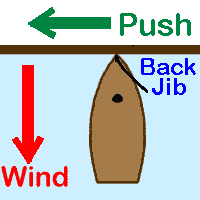 When there are no other boats coming, wait for the boat to swing in the wind slightly towards to way you want to go (if it will). Then Back the Jib by pulling the sheet on the Windward side; this can be helped by someone at the shrouds holding the Jib out against the wind. The person holding the Bow Warp now pushes the Bow sideways as hard as they can (without falling in) and clambers aboard, probably holding onto the Forestay.
When there are no other boats coming, wait for the boat to swing in the wind slightly towards to way you want to go (if it will). Then Back the Jib by pulling the sheet on the Windward side; this can be helped by someone at the shrouds holding the Jib out against the wind. The person holding the Bow Warp now pushes the Bow sideways as hard as they can (without falling in) and clambers aboard, probably holding onto the Forestay.
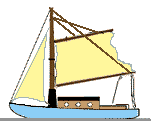 Sometimes, if the wind is quite strong and blowing directly off the bank, even letting the Mainsail right out will not be enough to spill all the wind out of it, and you may have trouble getting off. To help in this situation, hold the Boom up with the Topping Lift(s) (i.e. omit item (6) above), and possibly let down the Peak as well - this is called Scandalising. The Mainsail will now be very much less efficient and you will find it much easier to turn away from the wind. You don't get anything for nothing, because the Mainsail is now much trickier to control, so as soon as you are sailing normally you should set the sail properly.
Sometimes, if the wind is quite strong and blowing directly off the bank, even letting the Mainsail right out will not be enough to spill all the wind out of it, and you may have trouble getting off. To help in this situation, hold the Boom up with the Topping Lift(s) (i.e. omit item (6) above), and possibly let down the Peak as well - this is called Scandalising. The Mainsail will now be very much less efficient and you will find it much easier to turn away from the wind. You don't get anything for nothing, because the Mainsail is now much trickier to control, so as soon as you are sailing normally you should set the sail properly.
You can also Scandalise in narrow or crowded waters to slow down a bit - useful when approaching bridges or moorings, or when traversing Meadow Dyke and other such channels.
After all that, you've only just started to sail, and the fun really starts!
It isn't all dire warnings, because a little bit of thinking ahead means that you are likely to be enjoying sailing smoothly quite a bit sooner - which is much more interesting than getting tangled up with other boats or Lee shores.
Cap'n Jeremy's Helpful Hints - Back to Contents
The term 'Defensive Sailing' refers to an attitude rather than a fixed set of rules that can easily be written down in a section like this. It also means being considerate to all other users of the river, whether or not you think they are being nice to you. Taking care of your own boat is also a very important consideration. Some general guidelines to help you are presented.
This is sometimes easier said than done. It includes some of the following:
It is assumed that you are familiar with who has Right of Way when sailing. What is important is not to 'stick to your rights' at the risk of having a nasty bump, but give plenty of room and allow yourself space to take avoiding action, if necessary. This is not the same as 'giving way' when you should not - a collision is likely if both yachts turn the same way at the same moment to try and avoid each other.

When you are giving way to another yacht which has priority, do so decisively and in plenty of time so that they can clearly see where you are going.
'Tacking Duels' can be very exhilarating, but they need constant concentration. Always make it clear what you are doing (shouting 'Ready About' loud enough for the other boat to hear, etc.). Be prepared to let another yacht past rather than risk getting their Bow embedded in your Gunwale.
Officially, motor vessels (including yachts with their auxiliary engines in gear) are meant to give way to sailing vessels. However, they are still allowed to exist on the river (some might say this is a shame), and should be given enough space when you are tacking past them, etc.
Also remember that their helmsmen may have very little idea of what sailing boats do - clear signals of when you want them to go past often help a lot. If you have indicated a cruiser to come past your Stern when tacking (you, not the cruiser), he will sometimes not be as quick as you wanted and might not be clear of you by your next tack; as you waved him through, you will now have to put in a short tack rather than trying to stick to any 'rights'.
Sailing well does not just mean remembering a list of 'don'ts', but involves getting the most out of your boat (and sometimes your crew).
Setting your sails to get the best effect from the wind may mean frequent adjustments. If you are tacking, the Jib Sheets should be really tight - this can be very hard work for the crew member(s) concerned. If they get enthusiastic, watch that they don't pull the Jib over ready for the next tack too early, this will Back the Jib and is almost certain to put you up the bank. To really improve your progress when tacking, as you Go About move the Tiller gently and only a small amount (less than 30 degrees from the centre-line), so you 'creep' along the bank on each tack.

Looking for the 'best' wind can be worthwhile for increasing your speed. This is where I risk giving away my own secrets - on open Broadland rivers which are slightly higher than the surrounding fields, the wind lifts up the bank (or Rond) and is often stronger on the Windward side of the river. On the other hand, on wider rivers with trees around, there is sometimes a better breeze towards the Lee shore.
Cap'n Jeremy's Helpful Hints - Back to Contents
When approaching a mooring, it is vitally important to do so very slowly; you must kill virtually all the speed you have before you get to the bank. If your are coming in close to or alongside boats already moored, this aspect is even more essential.
Pick Your Mooring
This should normally be on a Windward bank (where the wind is coming from) - you should never attempt to come into a Lee shore under full sail. If you really want to moor on the Lee shore you should come into the other side of the river (or in open locations possibly moor on a Mudweight) to put your sails down, so that you can then drift, Quant or motor down-wind to your chosen spot. In some circumstances with a very light wind it might be possible for the experienced skipper to sail onto a Lee shore mooring under Jib alone. If you're not sure whether you can slow down adequately, don't try it.
The Ideal Mooring
Let's assume that you wish to moor on a Windward bank, with a nice firm edge for jumping onto, at the side of a nice wide river with very little current and no other craft moving on it (or even moored nearby).
There are two basic variations of the way of bringing the boat to a controlled stop to approach a mooring: 'Luffing Up' head to wind and 'Lying To' at an angle to the wind (sometimes known as 'Seaman's Hove-To').
In the Luffing Up method, you sail along until you reach a point downwind from the bank that you judge to be right, then head straight into the wind, so that your speed is reduced fairly quickly and you stop just as you reach the bank. This does not need so much space to manoeuvre, but does not have the same degree of control as Lying To. It is the traditional method on the Broads, and when executed correctly can be impressive - but if it is not judged right, it can be tricky to get out of safely. It does result in much flapping of sails, with a risk of injury from the boom or the possibility of the crew on the Foredeck being flapped overboard by the Jib.
In the Lying To method, you turn the boat to about 30 degrees from the wind, where you can slow down by letting the sheets out so the sails flap, or move forwards by pulling them in a little. It takes more space to slow down in this way, but there is very much more control of the boat, and the sails are flapping safely away from the people on board. It is important to remember that when sailing like this, the boat does not actually go straight forwards, but makes a lot of Leeway.
Initial Approach
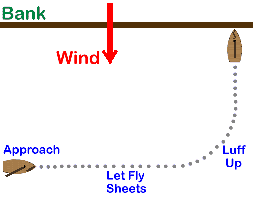 Sail parallel to the bank and far enough away from it to turn into the wind; if the wind is not coming straight off the bank, arrange it so that you are sailing more Upwind (rather than Downwind). Send a crew-member to the Foredeck to be ready with the mooring Warp, and Rond anchor (if necessary - for a bank with no posts or rings). Make sure you warn them if you are about to change tack, so they don't get swept off into the drink as the Jib comes across and is pulled taught.
Sail parallel to the bank and far enough away from it to turn into the wind; if the wind is not coming straight off the bank, arrange it so that you are sailing more Upwind (rather than Downwind). Send a crew-member to the Foredeck to be ready with the mooring Warp, and Rond anchor (if necessary - for a bank with no posts or rings). Make sure you warn them if you are about to change tack, so they don't get swept off into the drink as the Jib comes across and is pulled taught.
(1) Luffing Up
Before you come opposite where you want to moor, let go all of the Sheets to allow the sails to flap loosely and then turn straight into the wind; this is called 'Luffing Up'. While you are head to wind the boat will slow down. If you have judged the distance just right you will stop with your bows about one foot away from the bank.
(2) Lying To
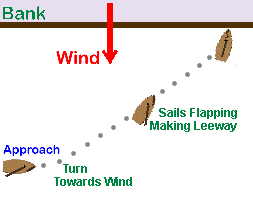 Quite a way before you come opposite where you want to moor, let the Sheets out carefully, and head closer to the wind. At this point the sails should be just flapping, but safely to the side of the boat and you will be slowing down. This is a point of sailing known as 'Lying To' or 'Seaman's Hove-To'. To slow down more, let the sheets out, to speed up a little, pull them in. You have should have good control of the boat at this slow speed, and be able to come to a stop with your bows close the bank - just be aware of the Leeway that the boat will be making; it is blown sideways by the wind and will not be moving exactly where it is pointing.
Quite a way before you come opposite where you want to moor, let the Sheets out carefully, and head closer to the wind. At this point the sails should be just flapping, but safely to the side of the boat and you will be slowing down. This is a point of sailing known as 'Lying To' or 'Seaman's Hove-To'. To slow down more, let the sheets out, to speed up a little, pull them in. You have should have good control of the boat at this slow speed, and be able to come to a stop with your bows close the bank - just be aware of the Leeway that the boat will be making; it is blown sideways by the wind and will not be moving exactly where it is pointing.
Making Fast
The Crew Member steps ashore with the Bow Warp and immediately turns and holds the yacht onto the bank.
He or she then ties the rope to a convenient mooring-post so that it is tight, or puts Rond anchor in the
ground and ties the rope to it. Safely and securely putting the Rond anchor in is done by placing the anchor with
the point down, then either : (a) Soft Bank Standing on the ring and stamping the point into the bank with
the other foot, or (b) Hard Bank Wiggling the point down into the ground (this saves bruising your foot!).
Possible Problems
All right, it does not always go that smoothly. Sometimes the problem may be due to circumstances, sometimes you don't judge it quite right.
Other Craft About
You can either sail up and down a bit until they go away, or make very sure that they know what you are about to do - remember your manoeuvre involves a sudden change of direction which might take a cruiser by surprise. If you are coming in beside a boat already moored, allow a little extra space to Luff Up in for safety, and be prepared to throw your Bow Warp to someone on that boat. Coming in with the Lying To method, slow down even more than you might for a soft bank.
A Strong Current
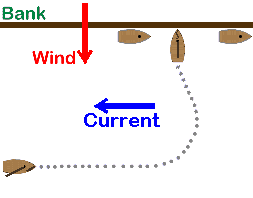 On the River Bure at or below Thurne Mouth there may be a significant flow; look carefully at small floating objects close to the bank to judge the speed. This means that you may 'crab' as you approach the bank - your forward speed may be less than your sideways speed. If the wind and tide are together, heading into their combined force will slow you down as if it were a stronger wind. If they are in opposite directions, the tide may well have more effect than the wind as soon as your sails are no longer full - beware of being swept along the bank at quite a rate, especially if you are trying to moor in a small 'gap'. Because the Lying To approach gives more control, this is less likely to be a problem - but you should still watch out carefully for the current.
On the River Bure at or below Thurne Mouth there may be a significant flow; look carefully at small floating objects close to the bank to judge the speed. This means that you may 'crab' as you approach the bank - your forward speed may be less than your sideways speed. If the wind and tide are together, heading into their combined force will slow you down as if it were a stronger wind. If they are in opposite directions, the tide may well have more effect than the wind as soon as your sails are no longer full - beware of being swept along the bank at quite a rate, especially if you are trying to moor in a small 'gap'. Because the Lying To approach gives more control, this is less likely to be a problem - but you should still watch out carefully for the current.
A Soft or Reedy Bank
In this case you have a little more 'margin for error', and should aim to come in firmly (but not at full speed). The crew member with the Warp may have to jump towards firm ground, and will possibly get wet feet!
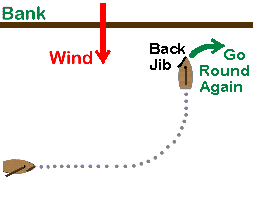
Coming in too Slowly - Luffing Up
This is usually the safest mis-judgement to make; if you are not sure of the weight of your yacht, and how fast its speed through the water will reduce as you Luff Up, you could aim to 'miss' in this manner as a practice run. Sometimes you can head 'off' the wind a bit, so that your sails are slightly full and get enough way on to make it as far as the bank (if you are lucky!). Or, you may be able to throw a Warp to someone on the bank (make sure it does not have a Rond anchor attached). If there is no luck on either of these options, get the crew on the Foredeck to Back the Jib on the side nearest the bank, get the boat sailing properly and go round again for a completely new approach. This time, start turning slightly closer to the bank.
Coming in too Slowly - Lying To
This is not likely to happen very often, but could be caused by the boat making more Leeway than you expected. You should be able to simply pull your Sheets in, get a bit of speed on and head into the bank further along. If you have 'run out of bank' to moor on, you can easily sail normally by heading away from the wind a little, to sail round again and make a second approach.
Coming in a Little Bit too Fast - Luffing Up
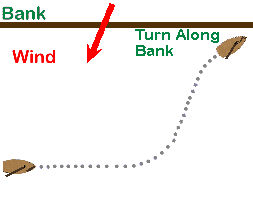 If you think you are at risk of 'bumping' the bank a bit harder than you would like, keep all your sails still flapping and turn slightly along the bank. Unless you have to turn so far that your sails start to fill and pull, you should still be slowing down. The Crew Member on the Foredeck can come Aft a bit and step off at the Shrouds; they could possibly assist the braking of the boat by holding back on the Bow Warp. Other boats moored nearby would limit this option.
If you think you are at risk of 'bumping' the bank a bit harder than you would like, keep all your sails still flapping and turn slightly along the bank. Unless you have to turn so far that your sails start to fill and pull, you should still be slowing down. The Crew Member on the Foredeck can come Aft a bit and step off at the Shrouds; they could possibly assist the braking of the boat by holding back on the Bow Warp. Other boats moored nearby would limit this option.
Coming in a Little Bit too Fast - Lying To
Again, this is not very likely to happen too often, you should be able to just let your Sheets out to reduce your speed. If necessary, keep the Sheets loose and the sails flapping as you turn a little along the bank while you continue to slow down.
Coming in Much too Fast
If you have turned too close to the bank, or did not let fly your Sheets early enough, you could make quite a messy hole in the boat. You must decide very quickly to turn away from the bank and go round again. In such a situation, don't move the tiller 'gently and smoothly' (as you may have been taught), but shove it as hard as you can. Make sure you warn all crew (especially the one on the Foredeck) of what you are doing. Again, this is unlikely with the Lying To approach, unless you have started your manoeuvre very much too late; in which case you can sail around and try again.
Mooring in the Middle of a Broad - Alongside Other Boats
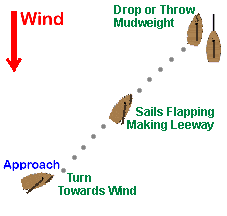 To moor by Mudweight in open water is easy - you 'Lie To' close to the wind or 'Luff Up' directly into it until you have stopped (there is usually more space on a Broad, so Lying To is preferable and safer). Then get your strongest crew member to throw the Mudweight as far forward as they can, (without going in with it!); make sure they are experienced enough to know what they are doing, if not, they should just drop or lower it over the side of the bow. Get your sails down (see below) reasonably quickly so that the yacht does not start to sail away again.
To moor by Mudweight in open water is easy - you 'Lie To' close to the wind or 'Luff Up' directly into it until you have stopped (there is usually more space on a Broad, so Lying To is preferable and safer). Then get your strongest crew member to throw the Mudweight as far forward as they can, (without going in with it!); make sure they are experienced enough to know what they are doing, if not, they should just drop or lower it over the side of the bow. Get your sails down (see below) reasonably quickly so that the yacht does not start to sail away again.
If you want to end up beside one or more other boats already moored in this way, approaching with the 'Lying To' method is usually best - because there is plenty of space on a Broad, and it gives you better control as you come close. From quite a way away, turn just 'off' the wind, heading well ahead of the moored vessel's bow. Control your speed (as above) by letting out your Sheets to slow down, or pulling in to move forward; once you are close to the moored boat (and nearly stationary), turn up towards the wind just ahead of them to drop your Mudweight.
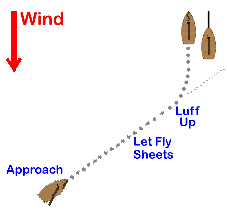 If you want to approach Luffung Up, then head across the wind close to their Stern and Luff Up before you get there so that you aim to be a few feet away from them and eventually stop well ahead of them.
If you want to approach Luffung Up, then head across the wind close to their Stern and Luff Up before you get there so that you aim to be a few feet away from them and eventually stop well ahead of them.
It is best if your mast is at least in line with the other boat's bow, or even your cockpit beside their mast. Only throw the Mudweight in then (not when you are exactly beside the target boat); this allows you to drift back on the Mudweight Warp so that it is taut when you are roughly in line. When throwing the Mudweight, try to throw it on the side away from those of boats already moored, to prevent the lines getting tangled. If your original aim was correct, you are now a few feet from your new neighbour, and can pass or throw mooring lines across the gap to secure the boats together.
Lowering Sail
As soon as you are secured to the bank, you need to get your sails down. Often it is best to lower the Mainsail first (so that the boat does not sail away again), but the order is not usually critical - if you have a furling Jib, start by getting rid of this. Mostly, the process is the reverse of 'Hoisting Sail' (see Section 2). Start by raising the end of the Boom with the Topping Lift(s) - remember never attempt to lower the sail straight into the Crutches. Have a few crew on the cabin roof to gather in the sail as it is lowered. Let the Gaff down steadily, and reasonably level. Get a sail tie or two secured, then think about lowering the Boom/Gaff assembly into the Crutches. Lower the Jib and stow it where it won't get trampled on.
Mooring
Once your sails are safely lowered and stowed (as appropriate), secure your yacht to the bank. This may be by tying to posts, rings, trees, etc. with one of the knots suggested in the next section, or a Rond anchor stuck in the ground.
Direction of Boat
If it is quite breezy, you may want to have your yacht moored head to wind, to make life in the cockpit more comfortable; sometimes this is not feasible. Turn it by holding in one end and pulling on mooring Warps, passed outside such items as the Crutches, Shrouds, Forestay, etc. Such an operation is made very much easier if you can use the wind and/or current to help you - hold in the downwind/downstream end, and push out the other end.
Position of Boat
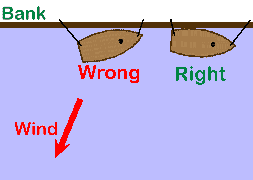 Most of the times people fall in are at moorings, and the way the boat is moored can be a factor. You and your crew are less likely to get a cold ducking if you have the Stern (where most people get on and off) close to the bank - remember the side of a yacht is curved, so you will need to let the Bow Warp out a bit, don't let an over-enthusiastic crew member pull in really tight on this. If you have two yachts moored beside each other, make sure their Sterns are close together, or someone is bound to go down the gap in the dark.
Most of the times people fall in are at moorings, and the way the boat is moored can be a factor. You and your crew are less likely to get a cold ducking if you have the Stern (where most people get on and off) close to the bank - remember the side of a yacht is curved, so you will need to let the Bow Warp out a bit, don't let an over-enthusiastic crew member pull in really tight on this. If you have two yachts moored beside each other, make sure their Sterns are close together, or someone is bound to go down the gap in the dark.
Position of Mooring Warps
Another cause of people taking a tumble (sometimes into the drink) is tripping over Mooring Warps. Try to arrange them so that they are not at knee-height. If you have the option, tie to parts of the bank staging instead of having a rope across the path going to a Rond anchor. If you tie to a tree, ensure the rope is secured very close to the ground. Sometimes it can help to place the Mudweight on top of the warp to hold it down to a safer height.
Very Strong Wind or Current
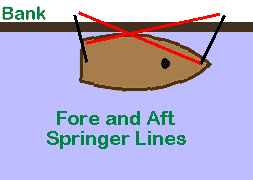 If there is a strong wind, or it looks as if it may 'blow up' a bit in the night; or in some cases where there is a strong current (such as the Lower Bure), it can be very helpful to have additional 'Springer' mooring lines. These run from the Bow cleat or ring on the boat to the bank opposite the Stern, and likewise from the Stern cleat to the bank beside the Bow. These ropes will virtually eliminate any fore and aft movement of the boat. You may need to be a little inventive about finding ropes to do this with, if your yacht only has two mooring warps - the Mudweight line could be used, and possibly the Mainsheet.
If there is a strong wind, or it looks as if it may 'blow up' a bit in the night; or in some cases where there is a strong current (such as the Lower Bure), it can be very helpful to have additional 'Springer' mooring lines. These run from the Bow cleat or ring on the boat to the bank opposite the Stern, and likewise from the Stern cleat to the bank beside the Bow. These ropes will virtually eliminate any fore and aft movement of the boat. You may need to be a little inventive about finding ropes to do this with, if your yacht only has two mooring warps - the Mudweight line could be used, and possibly the Mainsheet.
Cap'n Jeremy's Helpful Hints - Back to Contents
The object of virtually all the knots used around a boat is to be secure, so as not to come undone accidentally, yet be easy to untie when necessary. They are not just exercises to confuse innocent trainees with incomprehensible knitting. It is assumed that you know how to tie the basic knots required, so this section does not tell you how to tie them, but when to use them.
Mooring to a Post - Clove Hitch (Short Term only) or Round Turn & Two Half Hitches (Long Term)
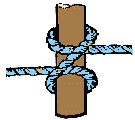 When you first come alongside, it can be a great help to take a single turn of the Warp round a post. With very little effort you can kill any of the boat's speed (much easier than trying to dig your heels into a slippery, muddy bank). Just one turn round a post enables the smallest crew member to hold a yacht comfortably even in a very strong wind. If you arrange to drop the loop onto the post so that the standing end (the bit of rope going to the boat) is on top, it can be pulled tight and a second (identical) loop dropped on to make a Clove Hitch.
When you first come alongside, it can be a great help to take a single turn of the Warp round a post. With very little effort you can kill any of the boat's speed (much easier than trying to dig your heels into a slippery, muddy bank). Just one turn round a post enables the smallest crew member to hold a yacht comfortably even in a very strong wind. If you arrange to drop the loop onto the post so that the standing end (the bit of rope going to the boat) is on top, it can be pulled tight and a second (identical) loop dropped on to make a Clove Hitch.
Although easy to tie, a Clove Hitch really ought not to be used for a permanent (overnight) mooring, or in very windy conditions, because continued tugging on the Warp can eventually shake it loose. Once you are happy with your mooring, it is best to re-tie with a Round Turn & Two half Hitches.
Mooring to a Ring or Tree - Round Turn & Two Half Hitches
 Although it is technically possible to tie a Clove Hitch in such circumstances, it is quite tricky and then may be difficult to untie. When mooring to a Ring, it may be neater and easier to take the Warp once through it and back to the boat for securing there.
Although it is technically possible to tie a Clove Hitch in such circumstances, it is quite tricky and then may be difficult to untie. When mooring to a Ring, it may be neater and easier to take the Warp once through it and back to the boat for securing there.
Securing a Dinghy - Bowline, or possibly Round Turn & Two Half Hitches
 The dinghy Painter should be less than 1 metre long (that's about a yard for traditional measurers). Any temptation to tie it with a Highwayman's Hitch (for quick release) must be avoided, because the constant pulling of the dinghy will distort the knot into a jammed state which is virtually impossible to get undone, let alone release quickly.
The dinghy Painter should be less than 1 metre long (that's about a yard for traditional measurers). Any temptation to tie it with a Highwayman's Hitch (for quick release) must be avoided, because the constant pulling of the dinghy will distort the knot into a jammed state which is virtually impossible to get undone, let alone release quickly.
Securing the Life-Ring - Highwayman's Hitch
This should have no repeated tugging, and would definitely need to be released quickly, so a Highwayman's Hitch is the appropriate knot.
Stopper Knots in Sheets - Figure of Eight
 Don't forget to check every now and then that these have not shaken loose. If you want extra protection from losing the sheet, tie a second Figure of Eight in the Mainsheet several feet in from the end - so that the knot is close to the block when the Boom is at its furthest extent.
Don't forget to check every now and then that these have not shaken loose. If you want extra protection from losing the sheet, tie a second Figure of Eight in the Mainsheet several feet in from the end - so that the knot is close to the block when the Boom is at its furthest extent.
Reefing Points (if Fitted) and Life Jackets - Reef Knot
 A Reef Knot is normally only suitable for joining the two ends of the same piece of rope. Be wary of using a Reef Knot for two ropes which appear identical, you could have a problem if one is more supple than the other - a Sheet Bend is a better bet.
A Reef Knot is normally only suitable for joining the two ends of the same piece of rope. Be wary of using a Reef Knot for two ropes which appear identical, you could have a problem if one is more supple than the other - a Sheet Bend is a better bet.
Joining or Extending Warps, etc. - Sheet Bend
 You can use the loop that is spliced into the end of most Warps as the start point of this knot, which means you only have to pass the second rope through the existing loop, around and under itself. Use this knot in preference to a Reef Knot, even if the two ropes appear to be similar in thickness one may be more flexible than the other.
You can use the loop that is spliced into the end of most Warps as the start point of this knot, which means you only have to pass the second rope through the existing loop, around and under itself. Use this knot in preference to a Reef Knot, even if the two ropes appear to be similar in thickness one may be more flexible than the other.
Joining a Thin Rope to a Thick one - Double Sheet Bend
 Add the extra turn if there is much difference between the thickesses of the two ropes, or if one is quite stiff. You can still use the loop spliced into the end of most Warps as the start point, especially if you are attaching a thinner bit of line to it. This is still quite easy to untie, even if it has had a lot of strain on it.
Add the extra turn if there is much difference between the thickesses of the two ropes, or if one is quite stiff. You can still use the loop spliced into the end of most Warps as the start point, especially if you are attaching a thinner bit of line to it. This is still quite easy to untie, even if it has had a lot of strain on it.
Attaching to a Spar (or Thick Rope) to pull along it - Rolling Hitch
 Use this knoit if you need to pull along a spar (such as to yank a Quant Pole out of some particularly sticky mud), or along a thick rope - to take the strain off a tight sheet with a second person, for example.
Use this knoit if you need to pull along a spar (such as to yank a Quant Pole out of some particularly sticky mud), or along a thick rope - to take the strain off a tight sheet with a second person, for example.
It is a bit like a clove hitch with an extra turn, but it is not symmetrical; note which way the strain is designed to go, it only rolls tight in that direction.
Cap'n Jeremy's Helpful Hints - Back to Contents
A strong wind can give very exciting sailing, but it also makes the boat very hard to handle and can mean that bits break (sometimes useful things like the Mast or the Gaff). 'Taking a Tuck In' reduces the sail area and makes life much easier - often you can even sail faster, because you have full control of the sail instead of having to spill wind out of it a lot of the time.
If you have printed out these instructions and have not had command of Reefing a yacht very often, or are unsure in any way, have the hard copy of this section in the Cockpit (held down so that it won't blow away) while you do it. .
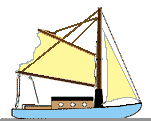 It is essential to be Head to Wind (See Section 4 for more details). Try to find a spot in the Lee of some trees if you can, to make life more comfortable.
It is essential to be Head to Wind (See Section 4 for more details). Try to find a spot in the Lee of some trees if you can, to make life more comfortable. 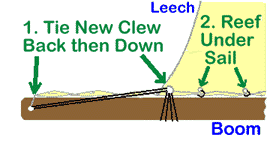
When you set sail again, you will probably find that the Tiller is much lighter and easier to handle. This is partly because there is now less total wind force on the sails, but also because its centre point of action is slightly further forward - you have reduced the Mainsail but not the Jib - and is closer to the Keel and the centre of sideways drag. Therefore, you have a reduction in the amount of 'Weather Helm'. When some yachts are fully Reefed, the Weather Helm is completely eliminated and the boat no longer has the safety feature of naturally heading up into the wind when you let go of the Tiller.
Cap'n Jeremy's Helpful Hints - Back to Contents
It is quite evident that to get your yacht under any of the bridges on the Broads you will need to lower the mast. The different yachts vary in exactly how easy this is to achieve, but the principles are basically the same.
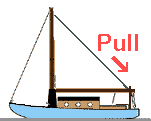
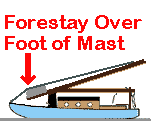
Raising the Mast
Raising the Mast is roughly the reverse of lowering it. You will probably need to give it a good shove up to get it going before the Forestay comes into effect. Have a crew member on each side of the yacht to prevent the Shrouds, etc., getting caught round the corners of the cabin roof or under the Tiller. Don't forget to do up the Keeper in the Forepeak, as well as cleating the Forestay nice and tight.
Shooting Bridges
To approach a bridge under sail, take your sails down under way, quickly lower the mast as you go under the bridge, then raise it again and hoist the sails without using Quant or engine is called 'Shooting a Bridge'. It takes good judgement and a good crew to achieve it successfully. If you do try it, have a 'contingency plan' in case you don't get everything down in time (make sure the helmsman knows to turn away!).
Cap'n Jeremy's Helpful Hints - Back to Contents
If sailing takes so much time to learn, you might think it should be easy to motor along.
In fact, many people who are very good at sailing a yacht don't appreciate some important aspects of how different the handling can be when using the engine - most especially how difficult it is to stop.
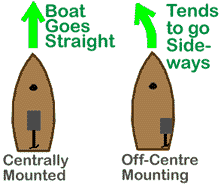
The engines in the yacts vary, many of the older wooden boats have petrol engines - mostly of the Stuart Turner type. These can be a little temperamental at times, and should be treated with respect and care. A particular point to note on these boats is that the engine (and propeller) are usually mounted off-centre, which causes interesting challenges when manoevering (see various tips below). Some more modern craft have a diesel engine. Usually, these are very simple to operate, very reliable and usually centrally mounted (which simplifies a lot of the aspects listed below); this also means the outflow from the propellor washes past the rudder, for better control under power.
Starting the Engine
Some of the Stuart-Turner Auxiliary Engines can be tricky to get going. The larger boats mostly have electric start, which makes life a lot easier. Crank-Starting is more technique than brute force, you need to apply the 'push' at just the right part of the total turn. You will probably find out for yourself the best control settings for your own boat, but here are some guidelines which might work for a cold engine: (Some boats no longer have a manual Choke vent, so ignore references to this)
Note that when re-starting a 'warm' engine it is very unlikely you will need to close the Choke vent.
Starting a diesel engine is very much easier - typically you turn the key or switch until the 'Glo-plug' light comes on, count to twenty, then turn it a fraction further to fire and it just about always starts first time!
Possible Starting problems:
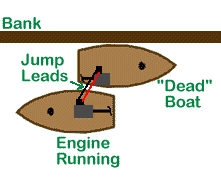
1) Flat Battery - Engine Won't Turn Over
This often results from using the lights a lot the night before. You will need to find someone with a set of Jump Leads, get another yacht alongside such that their engine is right next to yours (with it running), pull both batteries out to get the Jump Leads on, connect up and have another go at starting.
2) Engine Turns Over but won't Fire
If it doesn't want to go after several tries, don't flatten the battery with more fruitless attempts. It could be one of several things, but a damp Spark Plug is possible. This one might be for the more able mechanic - remove the Spark Plug and heat the 'business end' in the flame of a gas ring or put it in the oven for a few minutes (don't heat it with a match, which will soot up the gap); replace firmly (but not too tight) and try starting again.
Setting Off
It is certainly not always as easy as shoving the Gear into 'Ahead', opening the Throttle and going. The Rudder acts at the Stern of the boat, so when you try to steer off a mooring you are likely to swing the Stern in and bump the bank.
There are at least three complications to be aware of : Wind, Which Side the Engine is & Lack of Steerage Way.
1. Wind
If you are on a Lee Shore, the wind can make life quite tricky; you will need to get the Bows right out from the bank (possibly with the Quant pole) before you engage gear. When motoring against a very strong wind, your engine may not be powerful enough to make any headway unless you take down the Mast (Section 7).
2. Which Side the Engine is Located
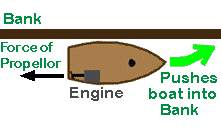 This aspect is an easy one to overlook; because on many yachts the engine is offset to one side, it will tend to push the boat the opposite way, i.e. if the engine is on the Port side, the yacht will tend to go to Starboard. This effect is greatest when stationary or moving slowly - it is virtually impossible to motor straight off a mooring if your engine is on the outside (away from the bank), its force will push you back into the bank, whether you use Ahead or Astern. As in Item (1) above, you need to get the Bows right out before engaging gear.
This aspect is an easy one to overlook; because on many yachts the engine is offset to one side, it will tend to push the boat the opposite way, i.e. if the engine is on the Port side, the yacht will tend to go to Starboard. This effect is greatest when stationary or moving slowly - it is virtually impossible to motor straight off a mooring if your engine is on the outside (away from the bank), its force will push you back into the bank, whether you use Ahead or Astern. As in Item (1) above, you need to get the Bows right out before engaging gear.
3. Lack of Steerage Way
The Tiller (and Rudder attached to it) will only have any effect when you are moving through the water, especially on yachts with the engine on one side. Therefore, you will be partially helpless until you have got some way on the boat. Boats with a central Propellor suffer less from this problem, because the outflow from the prop is acting direcly on the Rudder. This makes it all the more important to check that the river is clear before moving away from the bank and to be certain of how you intend to achieve your objective of setting off. In particular, don't be casual about handling under engine.
Under Way
Remember that you are now a 'Motor Vessel' and should keep to Starboard (the Right Hand side of the river or channel). Also, that you must give way to all yachts under sail; this can be difficult, especially if they are tacking, because you do not have much 'go' to get past them between tacks. To achieve this, be as close to their stern as you dare when they go about, stay close to the bank and give it all the Throttle you've got.
The most important thing to remember is how difficult it is to stop. Although the engine may seem very weak, you are probably travelling considerably faster than the yacht normally sails. This weakness of the engine makes the stopping distance of your heavy wooden yacht very long. Be aware of this all the time, and particularly when meeting yachts under sail (such as around bends in the River Ant), or approaching bridges and Moorings (see below).
Turning - It is very much easier to turn such that the engine is on the outside of the bend (for yacths which have the engine offset to one side). If you can do this, leave the throttle well open as you turn. If you have to turn with the engine on the inside, cut the throttle right back to enable the boat to swing round.
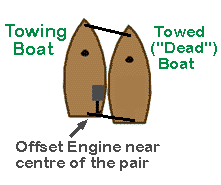
Towing - Officially, hire boats are not meant to tow other vessels, but sometimes it is expedient. This should only be done by people who have the relevant experience and authorisation. Normally, the best method is to lash the unpowered boat alongside very tightly. If the towing boat has an offset engine, try to arrange it so that yacht's engine is on the inside of the pair (such that the propeller is roughly central and pushing in the middle of the combined assembly) - although this is not always easy. When it is not possible to lash alongside, tow with a reasonable length of Warp, to enable the unpowered boat to come partially alongside if the towing boat has to slow down. Have someone assigned to watch the tow-rope At All Times to make sure it does not get tangled into the propeller.
Coming In To Moorings
In the same way as sailing up to a mooring, you should aim to slow down gradually as you approach, and be stationary just before you get to the bank. At the risk of repetition, it cannot be stressed too much how ineffective the Auxiliary Engine of a yacht can be when trying to use it as an immediate brake. Make sure you slow down well in advance, and come close to the bank with minimum Throttle setting (Idling); you can then use a few bursts of 'Astern' to kill your speed completely without the risk of bumping the bank or other moored boats. A common mistake is to keep at 'Full Ahead' until the vessel is one boat's length from the desired mooring, then to try and use 'Full Astern' in the vain hope that it will stop in time - this does not work (and you're bound to cause a nasty crunch!).
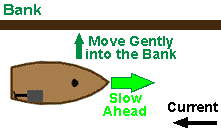
Strong Wind or Current - Be especially aware of a strong current (such as on the Lower Bure), and aim to be heading into it as you come alongside. This enables you to be going 'Dead Slow Ahead' with some steerage way, yet stationary with respect to the bank. With a strong current from behind you would lose steerage as you try to stop close to the bank, and could run into difficulties. If there is little current but lots of wind the principle is similar - anyway, you are very likely to want to moor with your bows pointing into the wind, to avoid a nasty breeze in the cockpit. However, if the wind and current are in opposition, it is probably best to moor heading into the current, then turn the boat using ropes.
Cap'n Jeremy's Helpful Hints - Back to Contents
A dinghy can be an invaluable aid in learning to sail. It provides a reasonably safe vessel for the novice to take sole command of, and it responds very quickly to Tiller or Mainsheet adjustments - giving immediate 'feedback' of efficient (or otherwise) sailing.
Unfortunately, in the context of sailing yachts, a dinghy tends to get in the way a bit; it slows you down and can bump against the bank when tacking. Whenever possible, encourage crew to sail it to your day's destination; make sure they don't get left behind or run into serious difficulties by sending them on ahead of the yacht and keeping a good lookout; also advise any other boats you are sailing with to keep a watch on the dinghy.
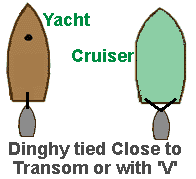
Towing a Dinghy
Have the dinghy Painter very short (less than 1 yard/metre), and tied on with a Bowline or Round Turn and Two Half Hitches. When sailing, you could have it even shorter, perhaps with the Bow of the dinghy tight against the yacht's Transom - this will reduce the amount of bumping around when tacking. When motoring, be aware of what might happen when you go Astern; allow the dinghy room to swing and try not to crush it if you go backwards into a mooring. This is when it is important to have a knot that can be untied quickly, so that you can move the dinghy to the shrouds.
If towing behind a motor cruiser, it is sometimes useful to tie the dinghy in a 'V' from the two cleats or rings at the sides of the boat, so that it hangs in a stable, Midships position. Often, you won't be able to see it from the steering position, so be very, very careful not to crush it when going Astern.
Rigging a Dinghy
In common with many other activities in life - this is easy when you know how! Different dinghies vary in detail, but the principles are mostly similar; and all of them can be unstable. Always wear a Life-Jacket when in a dinghy, even if you're in it for a very short time. Don't ever have more than one person standing up in a dinghy while you are rigging it (or at any other time) and never try to support yourself by holding the Mast - such as when getting in or out - the dinghy will capsize very quickly and you will get thoroughly wet!
Start with the dinghy as nearly head to wind as you can, and check you've got all the loose equipment required.
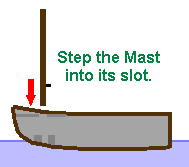
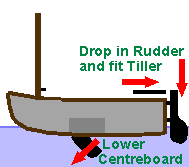
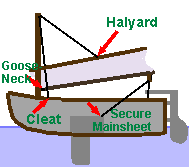
In either case, make sure you have got the Boom the right way up, with the sail going upwards.
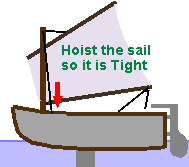
If you are sailing from a group of moored yachts, don't go down-wind of them - this is the easiest way to go, but the hardest way to get back from. If there is any current running, don't go downstream (for the same reason). If you should capsize (which is actually fairly tricky) - stay with the boat, don't try to swim even a few yards.
Cap'n Jeremy's Helpful Hints - Back to Contents
At first sight it may seem as if this document is a continuous list of dire warnings, telling you lots of things that you shouldn't do for fear of falling in, making a hole in the boat, ripping the sails or hurting someone. In fact, I have myself made an awful lot of the mistakes which I have warned against - and learnt the hard way. Others have been 'incidents' which occurred close to me, often making me very aware of the consequences.
But despite all this, remember that sailing is FUN! Don't be put off by the slightly negative tone of a few parts of this. To keep things in perspective, you may like to remember how to answer the following question: 'What's the first thing you do when you get to moorings?' - Put the kettle on, of course!
Jeremy Nunns, January 1999 (Version 5) - Minor Revisions November 2012
Contact Details :
E-Mail : JeremyNunns (at sign) iee.org
Cap'n Jeremy's Helpful Hints - Back to Contents